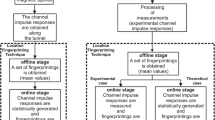Abstract
For many years, radiating cables have been used to provide coverage inside tunnels or underground venues. Due to the progress in transport technology and the increasing demand on mobile communications the necessity of having a clear understanding of the behaviour of the wireless channel in these environments is essential to successfully deploy radiating cable systems. In this context, the main objective of this paper is the study of the Doppler shift generated in a radiating cable system due to a mobile receiver changing positions along a defined path inside a tunnel. Doppler shift is an important effect in mobile communications as it degrades system performance. The study shows that a correct selection of the operating frequency used for the radiating cable can help reduce the Doppler shift and in turn the Doppler spread in the channel. At the same time the study reveals how the Doppler shift of a radiating cable generated by a fast-moving user is related to its radiation pattern, especially at the cable terminations. Finally, Doppler spread is accentuated when the cross section of the tunnel is reduced. These results can be used as a reference for improving the design of radiating cable systems applied in mobile communications with fast-moving vehicles, e.g. high-speed trains.











Similar content being viewed by others
References
Schwarz, S., & Rupp, M. (2016). Society in motion: Challenges for LTE and beyond mobile communications. IEEE Communications Magazine,54(5), 76–83.
He, R., Ai, B., Wang, B., Guan, K., Zhong, Z., Molisch, A. F., et al. (2016). High-speed railway communications: From GSM-R to LTE-R. IEEE Vehicular Technology Magazine,11(3), 49–58.
Ai, B., Cheng, X., Kürner, T., Zhong, Z., Guan, K., He, R., et al. (2014). Challenges toward wireless communications for high-speed railway. IEEE Transactions on Intelligent Transportation System,15(5), 2143–2158.
Okada, S., Kishimoto, T., Akagawa, K., Nakahara, Y., Mikoshiba, K., Horiguchi, F., et al. (1975). Leaky coaxial cable for communication in high speed railway transportation. The Radio and Electronic Engineer,45(5), 224–228.
Dudley, S. E. M., Quinlan, T. J., & Walker, S. D. (2008). Ultrabroadband wireless-optical transmission links using axial slot leaky feeders and optical fiber for underground transport topologies. IEEE Transactions on Vehicular Technology,57(6), 3471–3476.
Zhang, Y. P. (2001). Indoor radiated-mode leaky feeder propagation at 2.0 GHz. IEEE Transactions on Vehicular Technology,50(2), 536–545.
Morgan, S. P. (1999). Prediction of indoor wireless coverage by leaky coaxial cable using ray tracing. IEEE Transactions on Vehicular Technology,48(6), 2005–2014.
Xiong, F. M., & Andro, M. (2001). The effect of Doppler frequency shift, frequency offset of the local oscillators, and phase noise on the performance of coherent OFDM receivers. National Aeronautics and Space Administration.
Li, J., & Zhao, Y. (2012). Radio environment map-based cognitive Doppler spread compensation algorithms for high-speed rail broadband mobile communications. EURASIP Journal on Wireless Communications and Networking. https://doi.org/10.1186/1687-1499-2012-263.
Zhou, Y., Wang, J., & Sawahashi, M. (2006). Downlink transmission of broadband OFCDM systems-part II: Effect of Doppler shift. IEEE Transactions on Communications,54(6), 1097–1108.
Papanikolaou, N., Spanakis, A., Apostolakis, D., & Constantinou, P. (2004). Radio coverage measurements into tunnels with leaky section radiating cable. Paper presented at Ninth international symposium on computers and communications, Alexandria, Egypt.
Liérnard, M., & Degauque, P. (1999). Wideband analysis of propagation along radiating cables in tunnels. Radio Science,34(1), 113–122.
Zhang, Y., He, Z., Zhang, W., Xiao, L., & Zhou, S. (2014). Measurement-based delay and Doppler characterizations for high-speed railway hilly scenario. International Journal of Antennas and Propagation. https://doi.org/10.1155/2014/875345.
Bernado L., Roma, A., Paier, A., Zemen, T., Czink, N., Karedal, J., et al. (2011). In tunnel vehicular radio channel characterization. Paper presented at 73rd Vehicular Technology Conference, Budapest, Hungary.
Chen, X., Pan, Y., Wu, Y., & Zheng, G. (2014). Research on Doppler spread of multipath channel in subway tunnel. Paper presented at 2014 IEEE International Conference on Communication Problem-Solving, Beijing, China.
Cao, H., & Zhang, Y. P. (1999). Radio propagation along a radiated mode leaky coaxial cable in tunnels. Paper presented at 1999 Asia Pacific Microwave Conference, (Vol. 2, pp 270–272).
Lienard, M., Baranowski, S., Degauque, P., & Vandamme, J. (1994). Theoretical and experimental study of radio coverage in tunnels using radiating cable. Annals of Telecommunications,49, 143–153.
Stamopoulos, I., Aragón-Zavala, A. & Saunders, S. R. (2003). Performance comparison of distributed antenna and radiating cable systems for cellular indoor environments in the DCS band. In Proceedings of 12th international conference on antennas and propagation (pp. 771–774).
Saunders, S. R., & Aragón-Zavala, A. (2007). Antennas and propagation for wireless communication systems (2nd ed.). Hoboken: Wiley. ISBN 978-0-470-84879-1.
Landron, O., Feuerstein, M. J., & Rappaport, T. S. (1996). A comparison of theoretical and empirical reflection coefficients for typical exterior wall surfaces in a mobile radio environment. IEEE Transactions on Antennas and Propagation,44(3), 341–351.
Pérez-Fontán, F., & Mariño Espiñeira, P. (2008). Modeling the wireless propagation channel: A simulation approach with MATLAB. Chichester: Wiley.
Aragón-Zavala, A. (2017). Indoor wireless communications: From theory to implementation (1st ed.). Wiley: Chichester. ISBN 978-0-470-74116-0.
Acknowledgements
One of the authors, Jorge A. Seseña-Osorio wishes to thank the Mexican Consejo Nacional de Ciencia y Tecnología for the postdoctoral fellowship (CVU Number 207016).
Author information
Authors and Affiliations
Corresponding author
Additional information
Publisher's Note
Springer Nature remains neutral with regard to jurisdictional claims in published maps and institutional affiliations.
Rights and permissions
About this article
Cite this article
Aragón-Zavala, A., Seseña-Osorio, J.A. & Castañón, G. Doppler Shift in a Radiating Cable System in Tunnel Environments: A Theoretical Analysis. Wireless Pers Commun 110, 2131–2147 (2020). https://doi.org/10.1007/s11277-019-06833-w
Published:
Issue Date:
DOI: https://doi.org/10.1007/s11277-019-06833-w




